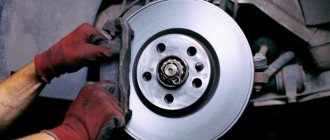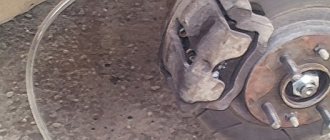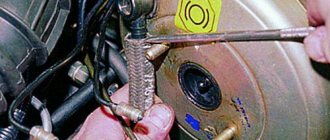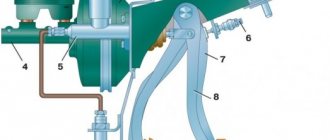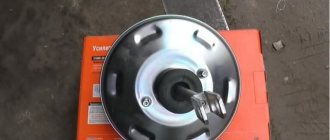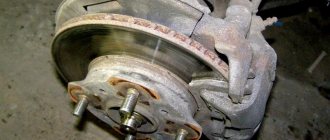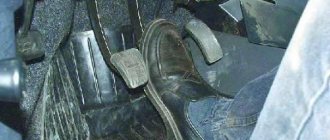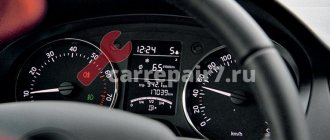A serviceable and efficient braking system of a car is a guarantee not only of road safety, but also often the safety of the life of the driver, passengers and pedestrians. And one of the signs of serious problems for the car and its owner is a situation when the brake pedal fails. This process can occur either slowly or quickly. It happens that a recessed pedal does not return to its place at all. In any case, all of the above signs are a reason for serious diagnostics of the brake system. However, first you should find out what caused the emergency situation.
The design and principle of operation of the car brake system
This is where you should always start. In order for a computer to work, you must first install an operating system on it. And for your head to work, you need to put at least basic information about the problem into it. This is precisely the device and principle of operation. Knowing and understanding them, you will understand a good half of the reasons for the failure of the brake pedal discussed here without additional guidance.
Device
The classic hydraulic brake system of a car without any bells and whistles consists of the following components and parts:
- Brake mechanisms - located on the wheel hubs, are equipped with brake actuators that press the pads against the discs or drums.
- The master brake cylinder is located under the hood and is a device with four compartments filled with brake fluid and pistons that “press” this fluid to the wheels.
- Lines or circuits are a system of tubes through which the working fluid flows from the master cylinder to the brake mechanisms.
- Vacuum booster - located between the master cylinder and the brake pedal, is designed to increase the foot force applied by the driver during braking.
- The brake pedal is a control element of the braking system.
- Expansion tank - a reservoir for filling, topping up and monitoring the level of working fluid, located directly above the main cylinder.
Naturally, this is a greatly simplified description of the braking system. But it is enough to understand why the brake pedal fails and where to look for the reason.
Principle of operation
The functioning of the car's braking system is ingeniously simple. To slow down the rotation of the wheels, the brake pads are pressed against the discs or drums. As a result of the action of friction forces, the motor energy generated by the motor is converted into heat and dissipated into the surrounding space. And where there is no energy, there is no movement.
A brake mechanism is used to press the pads against the discs or drums. It is implemented on calipers. Each of them has a cylinder with a piston, which, under the influence of working fluid supplied under pressure, pushes the pads. When fluid is not supplied, the pads are released under the influence of springs and braking stops. By adjusting the pressure of the working fluid, we can control the intensity of braking over a wide range.
In order to supply working fluid to the brake mechanisms at the right time, and even under high pressure, you need a master brake cylinder. Brake fluid must be present in it at all times. The expansion tank is responsible for this. If for some reason there is not enough liquid, the system starts working with air. And this is the main reason why the brake pedal fails.
The entire operating principle of the hydraulic brake system is based on the fact that the fluid does not decrease in volume under pressure. That is, if it is “pushed” through the tubes with a certain force, then the same force will be transferred to the actuators. If air, which is a gas and not a liquid, gets into such a system, problems begin. Gas decreases significantly in volume under pressure. This means that the force transmitted through the system decreases or disappears completely, without reaching the brake mechanisms.
The brake master cylinder is activated through the brake pedal inside the vehicle. The driver presses it, the force is increased by a vacuum booster and transmitted to the pistons. Well, they are already pushing the working fluid along the contours to the wheels. As a matter of fact, the described system may well work without a vacuum booster. It is needed only for the reason that the driver’s muscular strength is not enough to create the necessary pressure in the master brake cylinder. But we will return to this node later. In the section about myths from armchair “experts”.
Causes of failure and elimination
The brake pedal is slowly sinking, what should I do? Let's first find out the source of the defect
.
- Critical fluid level in the system;
- Poor quality liquid;
- Defects in the brake head cylinder;
- Incorrect replacement of brake pads;
- Poor quality pads;
- The gap level does not meet the required level;
- Aging of pedal metal;
- Problems with the vacuum pump.
The foot brake pedal is the most trouble-free of all.
. It breaks only in extreme cases. The brake mechanism itself is very complex structurally, so it’s up to you to fix it yourself or take the car to a car service center.
Bad brake fluid
is a major problem for our brakes. Over time, it corrodes the internal cavities and ruptures the hose. You can make sure by unscrewing the old hose and blowing into it, and do the same with the new one. The difference will be noticeable. This also applies to brake seals.
A rusty pedal can be easily removed and a new one put in its place. The lever movement should be free, without coercion, moving back all the way. If this is not the case, then look for problems.
Piston clearance
You can check its correctness using the pedal. Push your hand all the way and release. The return should be a two-stage process: the first part is light up to half, and the second is slightly tense (as if finishing is going on). In fact, it's the stock that brings it. If there is no such barrier, then the gap is too small. Most often, such a disease is inherent in the vast majority of domestic cars.
Failure can also occur after installing new pads. Don't worry, it's natural. Simply add fluid to the recommended level. The required amount cannot be filled immediately, since the pads have not yet been used. Top it up and everything will fall into place. See the article “How and where to fill brake fluid.”
Jerking and beating. This is a common occurrence with new brake pads. You need to travel about 400-600 km. so that the discs eat out the contour in the pads. Then the feeling on the pedal will stop. If the story continues, then look for a problem in the brake disc. Most likely it is deformed. Needs complete replacement or sanding.
There cannot be any problems as such with the vacuum pump, unless you get into an accident and the housing breaks. The reason is most likely cracks in the hoses, and as a result - airiness.
Well, we’ve sorted out the topic, the brake pedal is slowly sinking, what should I do? The list of reasons is exhaustive. We hope that our recommendations will be useful to many drivers. Share your tips and tricks. Let's work together to sort out difficult issues and look for solutions.
The serviceability of the braking system on any car is, for obvious reasons, of paramount importance, since overall driving safety directly depends on the effectiveness of the brakes. Taking into account the above, any deviations from the norm (even minor ones) in the operation of this unit are a reason to immediately identify the cause of the malfunction. In this article we will talk about what to do if the brake pedal fails while the engine is running, problems arose after replacing the brake fluid, bleeding the brakes or other elements of the brake system, etc.
Read in this article
Different types of brake pedal failure
Now let’s look in general terms at the types of our malfunction. The fact is that the brake pedal can fail in different ways, and this must be taken into account when looking for the cause. It is also important to take into account the circumstances under which failures occur. This helps to quickly eliminate breakdowns that have nothing to do with individual situations.
Types of brake pedal failure:
- with the engine running;
- after replacing the pads;
- after bleeding the brakes;
- sudden dips;
- smooth dips;
- the pedal sometimes falls;
- the problem disappears after several clicks;
- The pedal falls down and the fluid does not flow out.
If the pedal fails when the engine is not running, this means a complete lack of brakes and serious repairs to come. The good thing about such a breakdown is that it is not difficult to find its cause. Usually it is somewhere in a visible place, and is immediately revealed upon a quick inspection. But, as a rule, this does not happen very often. Basically, the brake pedal fails while the engine is running.
Failures after replacing pads, fluid and other manipulations with the brake system are separate stories. Each of them is discussed below. If you can match the problem with a recent repair or service to the braking system, this will be an excellent clue in finding the cause.
Sharp dips, smooth, periodic and disappearing after several clicks - all this does not help much in finding the problem. However, it allows us to assess the scale of the disaster. For example, if the pedal only sometimes fails, this indicates that the failure is not critical, and it will be more difficult to find. Sharp dips, on the one hand, are more frightening, but on the other hand, they simplify diagnosis.
The last common type of system malfunction is when the brake pedal sinks, but the fluid does not leave. That is, the tightness is not broken. What these types of symptoms indicate is also discussed below.
Identifying brake failure: tips
This problem can be immediately understood thanks to the third-party sounds that occur during the braking process: all kinds of creaks, noises and knocks. Or when the brake pedal began to be pressed too easily, and perhaps even failed. And we shouldn’t forget about the opposite signs, regarding the hard travel of the pedal or its depreciation.
Adviсe:
1. The area of the brake system and wheels is carefully inspected for leaks before each trip.
2. In the event of a violation of the correct operation of the brake system, a check is carried out and subsequent adjustment of the working and free play of the pedal.
3. The performance of the anti-lock mechanism and brake boosters is systematically inspected.
4. The degree of wear of the brake pads is constantly monitored. Moreover, to get a general picture, it is enough to inspect the pad of one wheel, where the minimum thickness should be approximately 1 mm.
5. The fastening of the master brake cylinder, hand brake, drive, axles and pad springs is regularly checked. And also the size of the gap between the brake pads and the drum.
6. Every 3 years, the brake fluid is replaced, the main thing is to use only the type of special substance and the same manufacturer that is indicated on the vehicle.
7. Once a week, the level in the tank is checked, where the fill level should be to the very top.
8. The parameters of the machine’s brake discs are also monitored. Their minimum average size must be no more than 10 mm.
9. All system pipelines and existing connections must be checked for leaks.
10. If the pistons jam, the brake cylinders are urgently replaced and treated with a special product such as WD-40. But the piston itself is installed in its original position using a pry bar, which should not touch the brake disc. After which the brake pedal is pumped in order to achieve ease of piston stroke.
11. The brake system is regularly checked for air accumulation, and if this occurs, the following actions are immediately performed. The required amount of fluid is added to the main cylinder and the valve of the second cylinder opens at the first wheel. Then, at the location of the plug, one end of a half-meter hose is immediately attached, and the second is lowered into the container with brake fluid and pumping of the system begins until air stops leaving the cylinder. Next, the valve is tightly closed with a plug.
12. Throughout the entire brake bleeding process, only high-quality fluid is always used. Moreover, the process itself, as a rule, begins from the rear right wheel, due to the enormous distance from the central cylinder.
If the driver always follows these tips, he will never encounter problems and will not wonder why the brake pedal falls when braking or when the engine is on.
Why does the brake pedal fail?
We've covered the basic information, now let's move on to specifics. To begin with, let’s make a kind of cheat sheet, which you can later use while at the car. Write it down on a piece of paper, take a photo on your phone, or, if you are reading this article from it, save the page in your bookmarks.
Causes of brake pedal failure:
- Brake fluid leak.
- Air in the system.
- Filled with low-quality brake fluid.
- Faulty brake master cylinder.
- The brake fluid has not been changed for a long time.
- Large gap between brake pedal and booster.
- Large gap between pads and drums.
- Hub malfunctions.
- Brake pad wear.
- Overheating of brakes.
- Parts of the brake system that are not ground in.
- Not bled brakes.
Now let's go through each point of our cheat sheet. In particular, we will consider what the essence of the cause is, how it manifests itself, where to look for it, and how to eliminate it. Even if DIY repairs seem scary and impossible to you, you will know what to tell a specialist. And he, in turn, will have no chance to impose on you non-existent breakdowns that require expensive “repairs”.
Reason #1. Brake fluid leak
The essence of this reason for the failure of the brake pedal is very simple. If the volume of liquid in the system decreases, it is replenished with air. As a result, you try to brake, and the master cylinder begins to compress the air in the system. Knowing the principle of operation, you now understand that your efforts do not reach the brake pads. The pedal fails. The car doesn't stop.
The first thing to do is look at the brake fluid level in the expansion tank. If it drops below the corresponding mark, you have already solved half of the problem. It can be much more difficult to find where the brake fluid went. If pedal failures were found in the same place where the leak occurred, it can be localized by puddles or spots under the car.
If you move away from the place, you should carefully inspect the details of the entire system. Brake fluid is very “greasy” and leaves clearly visible marks. First of all, you should look for them near the wheels. On hubs, calipers, suitable pipes. Then look under the hood. If the leak is there, it will most likely be found at the brake master cylinder. It happens that expansion tanks leak.
If a problem is found, it is solved by replacing the leaking part. Don't forget to bleed the brakes afterwards to remove air from the system. Most often, the working brake cylinders leak, then the pipes become unusable due to age and unfavorable conditions. Under the hood, leaks occur due to bad seals. They either dried out or were killed by low-quality brake fluid. But more on that later.
Reason #2. Air in the system
At first glance, it may seem that this reason is not much different from the previous one. But that's not true. The fact is that air in the brake system does not always mean a leak and insufficient fluid level in the expansion tank. It also happens that air forms in the highways in the form of traffic jams. When you look at the reservoir, the brakes don't work. That is, no pressure is created inside. The air fills a large volume, and the liquid in the tank occupies a normal level.
However, when you press the brake pedal and it fails, then at that moment the air locks are triggered. They compress under pressure, decreasing in volume. As a result, the force generated by the master cylinder is reduced. Often to such an extent that there is nothing left at all for the pads to operate. The system, despite all this, can remain completely sealed. It is clear that this situation greatly complicates the search for the cause.
On the other hand, if the fluid level in the tank is not the same and the pedal is weak, then this, first of all, indicates air. The problem is solved by pumping the system. It is quite possible that this operation was performed recently, but not with sufficient quality.
Reason #3. Poor quality brake fluid
90% of brake fluid consists of glycol components. The rest are so-called additives. They are needed to protect the system from destruction from the inside. So, if the liquid is of poor quality, these same additives may either not be there at all, or their correct concentration may be disrupted. In addition, they are not eternal, and over time they lose their original properties.
But let's get back to the low quality. Car enthusiasts who encountered this problem talked about how the rubber hoses of the highways delaminate and swell from the inside. Over time, this leads to their destruction and loss of tightness. As a result, it all comes down to reason number 1 on our list. The liquid leaves and air takes its place.
Actually, not only rubber pipes can suffer from low-quality brake fluid. This material is also used to make seals in the brake master cylinder. It is clear that their swelling and separation does not lead to anything good. Over time, the tightness will be broken, the fluid will leak under pressure, and the pedal will begin to gradually sink. The effectiveness of the brakes, of course, will suffer.
Reason #4. Faulty master cylinder
There are not many breakdowns of this unit. We have already outlined one of them above. In addition, natural wear of cylinder parts cannot be ruled out. In some cases, it is possible to restore it if suitable repair kits can be found. Most often, the master brake cylinder is simply replaced with a new one, or a used one, but in working condition.
Calculating this cause of brake pedal failure is not always an easy task. Of course, if it is clearly leaking, then it is visible to the naked eye. But as for wear, it can only be determined after dismantling and completely disassembling the unit. The last method, as a rule, is resorted to when nothing else helps to eliminate the failure of the brake pedal.
Reason #5. Brake fluid hasn't been changed in a while
According to the recommendations of most passenger car manufacturers, brake fluid must be changed to fresh every 40,000 kilometers. Not all car owners follow this rule. This is understandable. Such a mileage is not a guarantee that the liquid will instantly lose its properties and the pedal will begin to fail. For some car enthusiasts, it does not change after 100 or 200 thousand.
In addition to vehicle mileage, there are other ways to understand that it is time to replace the brake fluid. The very first sign of its “aging” is the loss of transparency and the acquisition of a dark color. This happens due to the so-called hygroscopicity. That is, it gradually gains moisture, which “kills” the original chemical composition. This may not cause the pedal to fail, but it will do so due to corrosion of the system parts. By the way, regarding water, and that it supposedly compresses more than brake fluid, it is said below in the myths from armchair “experts”.
Reason #6. Large gap between brake pedal and booster
Everything here is extremely simple. If the indicated gap is excessively large, when pressing the pedal, you simply do not transfer all the force assigned to it to the main cylinder. Identifying such a reason is even easier than all the others. Firstly, it usually does not occur if nothing has been done to the brakes before. Secondly, the brake pedal sinks, but the fluid does not leave. Thirdly, due to the large gap, the brakes are applied later than expected, which with some experience can be felt with your foot.
How the problem is solved depends on the design features of the particular vehicle. In addition to adjusting the gap, we should not forget about cases when it is completely absent. And the pedal fails in the described manner due to mechanical wear of parts. Accordingly, replacing them will help eliminate failures.
Reason #7. Large gap between pads and drums
If the car has drum-type rear brakes, it is worth looking into this possible reason as well. Its essence is as follows. When there is an excessively large gap between the pads and the working surface of the drums, contact between them begins late. As a result, part of the braking system runs idle at certain moments. As a result, the pedal fails.
It is clear that this cause is not accompanied by fluid leaks and other possible symptoms discussed here. Calculating the problem and its nature is also usually not difficult. This occurs when the pads are worn out, skewed or weakened. The clearance adjustment depends on the design of the brake system and is usually described if available in the owner's manual. There is no universal algorithm, so we won’t say anything about this.
Reason #8. Hub malfunctions
The most common malfunction in this direction is loosening of the hub mounts. In this situation, brake pedal failure may occur when cornering. This happens because the weakened hub warps and pushes the brake pads apart. If the latter are also quite worn out, then the problem intensifies.
Finding and eliminating this cause is as easy as shelling pears. To do this, you need to hang up all the wheels one by one, remove the rims and walk through the remaining parts with your hands. If something is weakened somewhere, it is easily determined. The repair is so simple - tighten it, install the wheels and that's it. It happens that when checking, a part dangles, but the fasteners seem to hold well. In this case, wear and tear, as they say, is evident. Only replacement helps here.
Reason #9. Brake pad wear
Worn pads do not always manifest themselves in the form of brake pedal failure. But this reason cannot be excluded from the cheat sheet. The essence of the problem should be obvious. To “get” to the working surface of the discs or drums, thin worn pads must travel a long distance. Accordingly, they cover part of this distance empty, which is why the brake pedal falls under their feet.
In this case, the brakes themselves do not disappear, but only begin to work later. This allows you to understand, without unnecessary movements, almost from the first time, what is the reason for the failure of the brake pedal. It becomes wadded or excessively soft only at the beginning of its stroke, and then it works as it should. If this is the case for you, then first of all, pay attention to the degree of wear of the pads. Don't forget that there are two of them on each wheel. People often forget to look at the block from the inside. But it does not have to wear out exactly as much as the external one.
Eliminating the cause is obvious. Pads to be replaced. It is better to change the entire set at once. After replacement, do not forget to bleed the brakes. Sometimes this is not absolutely necessary. But only sometimes.
Reason #10. Brake overheating
This happens infrequently, but it cannot be ruled out as an option either. The easiest way to overheat the brakes is when driving in city mode on congested roads. Each car has its own limit in this regard. It all depends on the design, quality of materials, how the cooling is arranged, and so on. It is clear that it is irrevocably impossible to eliminate such a cause of brake pedal failure. From time to time, she will still show herself.
On the other hand, overheating of the brake system is not a malfunction. That is, you won’t have to fix anything. So, if the pedal suddenly starts to fall through, pay attention to the driving mode. Perhaps you should either drive less aggressively or stop altogether before the car ends up with no brakes at all. Attention! It is strictly prohibited to check the temperature of the brake system with your hands. Burns guaranteed. Even the wheel rims should not be touched, since the brakes are partially cooled through them.
By the way, due to overheating, in addition to pedal failure, brake noise may be observed.
Reason #11. Not ground in brake system parts
When the brake pedal sinks after replacing the pads, beating may additionally be observed. In other words, there is a noticeable feedback to the foot when pressed. Often it is more like vibrations in nature. Fortunately, the symptom is not a malfunction. But provided that you really recently replaced the pads. If not, then you should look for the cause of pedal failure among other options.
As for the described symptoms, they disappear on their own. How fast depends on how much braking is used. Usually they talk about 500 kilometers. But this is not something that is approximate; it doesn’t say anything at all. So, if you drive this distance along the highway, the pedal dips, of course, will not disappear. When driving in city mode, the parts may get used to the first hundred kilometers. By the way, it also depends on the quality of the pads themselves.
The most important thing is that if after replacing the pads the brake pedal fails, then this should not be forgotten when the problem goes away. As a rule, upon completion of grinding in, the liquid level in the expansion tank drops slightly. It is advisable not to click this moment. The fluid needs to be topped up, and ideally the brakes need to be bled again.
Reason #12. Not bled brakes
This reason for the failure of the brake pedal could no longer be described separately. After reading, it should be clear what the air in the system leads to. However, pumping is often neglected or not done carefully enough. Therefore, let these couple of lines serve as a reminder to you. After any manipulations with the brake system, bleed it. It's not difficult, it doesn't take very long and it's free if you do it yourself. The only difficulty is that you need an assistant.
What's the result?
As you can see, there can be many reasons for a failing brake pedal. If you are not confident in your abilities and skills, then you should refrain from trying to fix the problem yourself and immediately contact experienced specialists. It must be remembered that it is recommended to change the brake fluid in a timely manner, since the maximum service life is no more than 24 months. Also a sign of the need for replacement is cloudiness and blackening, and the appearance of a characteristic odor. Note that brake fluid tends to accumulate water, which significantly deteriorates its properties over time and serves as an additional reason for replacement.
In such a situation, it is better to brake by gradually lowering the gear from high to low with shifting in a car that is equipped with a “mechanics” (manual gearbox). In some cases, you can use the contact emergency braking method, when the car deliberately collides with an obstacle and slows down after such contact or several contacts. This technique allows you to stop with minimal risks for the driver of a faulty vehicle and other road users.
Two myths from armchair “experts”
Since myths do not really help solve the problem of brake pedal failure, we will not describe them in detail. However, it is advisable to be aware of them, since the mentioned two reasons are often attributed to the problem at hand. Some do this due to a misunderstanding of how car systems work. Others try to impose non-existent problems in this way. Still others simply decided to get smart.
Myth one . The brake pedal fails when the engine is running due to a broken vacuum booster diaphragm. Actually this is not true. When the membrane is pierced, the pedal does not become weak. Quite the contrary. She becomes incredibly tough. The same as when the engine is turned off. The brakes, in this case, do not disappear anywhere, unlike the cases discussed above. You can easily verify this if you look at the section of the vacuum amplifier.
Myth two. The water that gets into the system is more compressed than the brake fluid, and because of this, the brake pedal may fail when braking. This is actually nonsense. The compressibility of all liquids is approximately the same. At least not so different that it somehow affects the volume under pressure in the car’s braking system. Of course, the presence of water in this case is bad. But not because it supposedly shrinks more. The pedal fails because of it for other reasons discussed above.
The brake failed at full speed: what to do?
First, try pressing the pedal sharply several times: perhaps its functionality will be partially restored. Next, assess the situation and identify a place where you can gradually turn. Then tighten the handbrake (don't do it too hard) and start shifting (if you have a manual transmission) to a lower gear. At the same time, when the lever is in “neutral”, press the accelerator (perform “re-throw”) to “prepare” the gearbox gears for emergency operation. As a last resort, choose the lesser of two “evils” - it is better to run into some obstacle near the road (roadside bushes are a good option) than to collide with a car.
The brake pedal fails - how to stop the car
Any driver simply must have these three methods in their arsenal, which significantly increase the chances of avoiding a tragedy in an emergency. The only “but” is that simple knowledge will not help. Need training. Therefore, without waiting for the next brake failure, practice in advance the proposed techniques for stopping the car (except for the last one).
The first method is engine braking. In theory, you should be familiar with this technique from driving school. If for some reason you don’t know this method of controlling a machine, let’s briefly consider the essence. Engine braking involves slowing down the car using the resistance of the lower gears of a manual transmission. In practice, everything is simple - the clutch pedal is depressed, the lowest possible gear is engaged, then the clutch returns to its original position. At the same time, we do not touch the accelerator. Even if not as effective as with standard brakes, the car will slow down. Sometimes this alone is enough to avoid trouble, or at least minimize its scale.
The second method is braking with the parking brake. Attention! The method is extremely dangerous if used inappropriately. You can make it even worse than it was, since there is a risk of blocking the rear wheels. However, learning how to effectively stop a car using just the parking brake is quite possible. To do this, you don’t need to pull it, as they show in films about racing. A confident but smooth pull of the handbrake is more effective than engine braking. So it makes sense to practice in advance on an area free of people and cars.
The third method is contact inhibition. The method is not pleasant. But when there are few options, then why not. The essence of the method is to try to stop the car by bringing its side parts into contact with surrounding objects. This could be a fence, a wall, and so on. By the way. This is the only one of the three methods that is not worth practicing unnecessarily, for the sake of training. Just know that sometimes you can get out of the current situation this way too.
Emergency situation
Brake failure while driving can be very dangerous. In this case, the main thing is not to panic. You need to smoothly tighten the handbrake, then, if the car has a manual transmission, gradually shift to lower gears.
During switching, be sure to re-throttle to equalize the rotation speed of the primary and secondary shafts. If possible, it is better to drive into a roadside obstacle than into an oncoming car.
Let's get started
Pumping is carried out in a certain sequence. The diagram is criss-cross. First, the air is pumped out of the rear right wheel. Then - from the front left. Next they move to the rear left and then to the front right disc. So, we tear off the bolts from the desired wheel, put the car on a jack and install the stops. It is impossible to lift on clamped blocks. Next, open the hood and add fluid to the maximum. We will need an assistant who will press the pedal several times on command.
Today, for no apparent reason, when I pressed the brake pedal, it sank almost to the floor. The brake grabs, but weakly. When the pedal is near the floor, only then does the car slow down. I barely made it to the garage. It is not a happy prospect to be the victim of an accident. Tell me what could be the reason. How to fix?
The reasons for the failure of the brake pedal can be: Very often the simplest thing is a decrease in the quality of the brake fluid. The liquid is hygroscopic and absorbs moisture; it may be time to foam the liquid and also check its level. It may also be that the main brake cylinder (GTC) has failed. After replacing brake discs or pads, such troubles sometimes occur. Incorrectly adjusted gap between the GTZ piston and the pedal in the car. Sometimes the pedals and their rods are rusty. Vacuum pump, etc. is faulty. The main thing is not to panic, but to identify and eliminate the reason why the pedal fails.
I would first check the brake fluid level, then bleed the brakes. If that doesn't help, then look at the brake master cylinder.
Perhaps air has entered the system; this may be due to wear on the brake pads, drums, or discs. We need to check everything and take action. Brakes are no joke. It is best to contact the service.
Ten years ago, due to inexperience, I poured low-quality brake fluid into the system. As a result, the brake hoses swelled and separated from the inside. This also rendered the cuffs in the GTZ unusable. And similarly, I had problems with the brake pedal. Air got into the system and everything had to be changed. Maybe you have the same problem.
Critical wear of system parts
Another reason for a failing brake pedal may be critical wear of the pads, drums and discs. The fact is that calipers and brake cylinders have a limited piston stroke. And when the pads and cylinders wear out, the pistons have to move further and further to create contact pressure between the pad and the disc (drum). And this requires an ever-increasing volume of liquid.
After releasing the pedal, the pistons partially return to their original position. And in order to make them extend to an increased distance the first time, press on the pads and press them with force against the drum or disk, pressing the pedal alone is not enough. The volume of the brake master cylinder is simply not enough to completely fill the system and bring it into working condition. The pedal is soft from the first press. But if you press it a second or third time, it will most likely become elastic and the brakes will work normally.
In this case, you need to check the condition of the actuators and replace them if critical wear is detected.
Rear brake pads are also often the cause of pedal failure. Many cars do not have a mechanism for automatically bringing them in as they wear out. And the distance between the shoes and the drum is adjusted by tightening the parking brake cables or bringing in the eccentrics. And in the free state, the pads return to their original position by a spring.
And it turns out that the pads are worn out, and so are the drums. The distance between these elements becomes unacceptably large. And to overcome this distance, until the pads touch the working surface of the drums, you will need to pump a lot of liquid into the system. Simply pressing the brake pedal will not physically allow you to do this. And there is a feeling of the pedal idling, of its failure.
There is only one way out: install the rear pads. In this case, it is necessary to evaluate the degree of production. On some car models, this happens: the pads and drums are so worn out that the cylinder pistons simply fall out from excessive extension. And this will cause a sudden and complete failure of the brake system.
>
Master cylinder malfunction
In the complete absence of brake fluid leaks, a symptom indicating a possible failure of the GTZ unit is that the pedal slowly sinks when held down, and only after the second or third pumping can it become rigid. Master cylinder failure is the result of worn piston seals and an inability to maintain high hydraulic pressure for effective brake application. The liquid is thus transferred back into the tank. The problem is solved by replacing the unit or rebuilding it using a repair kit.
Other causes of the problem: how to understand what’s what
Some signs of serious brake problems that require "fixing" can directly tell the owner what is causing the problem. So, if the pedal is too soft, then probably the reason lies simply in the presence of air bubbles inside the lines and cylinders. However, this may also indicate that the system has become depressurized and requires repair. But first you should still check the level of the mixture in the tank.
Depressurization of the brake system
If the pedal travel is too long, then the reason is wear of components such as drums or pads, which simply need to be replaced or adjusted. It is important to understand that this problem should be solved quickly - at any moment a car with such symptoms may simply lose its brakes.
Wear of brake pads and drums
When the brake discs wear out, the car behaves strangely: for example, the brake pedal pulsates, and the car vibrates when braking. Here we need correct diagnostics - it is worth assessing the wear of the bearings. If your brakes make a grinding sound, the cause is usually the pad rubbing against the brake rotor. It can be solved by boring the disc and replacing the pads - the work is painstaking and requires attention.
Why do brakes squeak?
The appearance of strange squealing sounds when braking indicates that the pads and calipers are not working correctly. And one more point regarding adding or filling brake fluid - it is important to use good compounds. It is also not recommended to mix liquids of different types. This can lead to blockage of the highways, as well as breakdown of the car stopping system as a whole. An incorrectly selected composition for the conditions of use can also be the culprit of pedal failure.
Failure of the GTZ can also lead to failure
If the GTZ fails, then it is easiest to replace it than to repair it. Usually the seals or piston wear out. In this case, the latter still moves when the brake is pressed, but it does not compress the fluid, which means the brakes disappear. Symptoms are the pedal sinking when the speed is sharply reduced or its slow movement downwards with careful pressure. In this case, liquid does not come out of the system itself.
Diagnostics of the brake system will help prevent pedal failure
Thus, there are quite a few reasons for brake failure. It is quite possible to carry out initial-level diagnostics on your own, and even in some cases it is possible to solve the problem yourself. But if you are unsure of your abilities, it is better to contact a car service. For preventive purposes, it is recommended to inspect the highways and assess their condition once every six months. If they are cracked, they should be replaced urgently. When buying new hoses, it is worth looking at when they were produced - it is important to take the newest ones, the old ones can quickly become unusable. The critical statute of limitations is two years. During this time, the rubber has already deteriorated and will not last long.
Large amount of water in brake fluid
One of the properties of brake fluid is its hygroscopicity, that is, the ability to accumulate moisture. With a large amount of it, the boiling point of the liquid decreases significantly. When the brakes are used intensively, overheating leads to a noticeable decrease in their efficiency. For this reason, the brake fluid needs to be periodically replaced with new one.
As an indicator, it visually darkens; there are also special devices for determining the percentage of moisture. The maintenance schedule for most cars requires that the brake fluid be replaced every 40,000 km or every 4 years.

